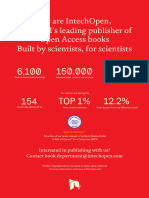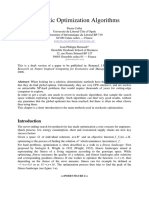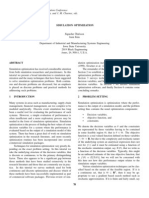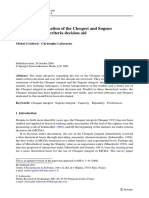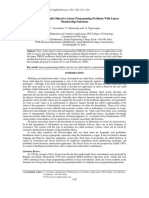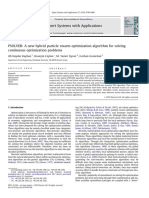Genetic and Other Global Optimization Algorithms - Comparison and Use in Calibration Problems
Genetic and Other Global Optimization Algorithms - Comparison and Use in Calibration Problems
Uploaded by
Oktafian PrabandaruCopyright:
Available Formats
Genetic and Other Global Optimization Algorithms - Comparison and Use in Calibration Problems
Genetic and Other Global Optimization Algorithms - Comparison and Use in Calibration Problems
Uploaded by
Oktafian PrabandaruOriginal Description:
Original Title
Copyright
Available Formats
Share this document
Did you find this document useful?
Is this content inappropriate?
Copyright:
Available Formats
Genetic and Other Global Optimization Algorithms - Comparison and Use in Calibration Problems
Genetic and Other Global Optimization Algorithms - Comparison and Use in Calibration Problems
Uploaded by
Oktafian PrabandaruCopyright:
Available Formats
Proc. 3rd Intern. Conference on Hydroinformatics, Copenhagen, Denmark, 1998. Balkema Publishers. pp.
1021-1028
Genetic and other global optimization algorithms - comparison and use in
calibration problems
D.P. Solomatine
International Institute for Infrastructural, Hydraulic
and Environmental Engineering, P.O.Box 3015, 2601 DA, Delft, The Netherlands
Email: sol@ihe.nl
ABSTRACT: Many issues related to water resources require the solution of optimization
problems. If the objective function is not known analytically, traditional methods are not
applicable and multi-extremum (global) optimization (GO) methods must be used. In the present
paper a brief overview of GO methods is given and nine of them are compared in terms of
effectiveness (accuracy), efficiency (number of needed function evaluations) and reliability on
several problems including two problems of model calibration. Two algorithms - adaptive cluster
covering (ACCO) and controlled random search (CRS4) - show better performance than the
popular genetic algorithm. The global optimization tool GLOBE used to perform the experiments
can be downloaded from www.ihe.nl/hi.
1. INTRODUCTION
Many issues related to water resources require the solution of optimization problems. These
include reservoir optimization, problems of optimal allocation of resources and planning,
calibration of models, and many others. Traditionally, optimization problems were solved using
linear and non-linear optimization techniques which normally assume that the minimized
function (objective function) is know in analytical form and that it has a single minimum.
(Without a loss of generality we will assume that the optimization problem is minimization
problem)
In practice, however there are many problems that cannot be described analytically and many
objective functions have multiple extrema. In these cases it is necessary to pose multi-extremum
(global) optimization problem (GOP) where the traditional optimization methods are not
applicable, and other solutions must be investigated. One of these typical GOPs is that of
automatic model calibration, or parameter identification. The objective function is then the
discrepancy between the model output and the observed data, i.e. the model error, measured
normally as the weighted RMSE. One of the approaches to solve GOPs that has become popular
during the recent years is the use of the so-called genetic algorithms (GAs) (Goldberg 1989,
Michalewicz 1996). A considerable number of publications related to water-resources are
devoted to their use (Wang 1991, Babovic et al. 1994, Cieniawski 1995, Savic & Walters 1997,
Franchini & Galeati 1997). (Evolutionary algorithms (EA) are variations of the same idea used
in GAs, but were developed by a different school. It is possible to say that EAs include GAs as a
particular case).
Other GO algorithms are used for solving calibration problems as well (Duan et al., 1993,
Kuczera 1997), but GAs seem to be prefered. Our experience however, shows that many
practitioners are unaware of the existence of other GO algorithms that are more efficient and
effective than GAs. This serves as a motivation for writing this paper which has the following
main objectives:
Proc. 3rd Intern. Conference on Hydroinformatics, Copenhagen, Denmark, 1998. Balkema Publishers. pp.1021-1028
to classify and briefly describe GO algorithms;
to demonstrate the relative performance of several GO algorithms, including GAs, on a
suite of problems, including model calibration;
to give some recommendations to practitioners whose problem is formulated as a GOP.
2. APPROACHES TO SOLVING OPTIMIZATION PROBLEMS
A global minimization problem with box constraints is considered: find an optimizer x* such
that generates a minimum of the objective function f (x) where x0X and f (x) is defined in the
finite interval (box) region of the n-dimensional Euclidean space: X = {x0Rn: a#x#b}
(componentwise). This constrained optimization problem can be transformed to an
unconstrained optimization problem by introducing the penalty function with a high value
outside the specified constraints. In cases when the exact value of an optimizer cannot be found,
we speak about its estimate and, correspondingly, about its minimum estimate.
Approaches to solving this problem depend on the properties of f(x):
1. f(x) is a single-extremum function expressed analytically. If its derivatives can be computed,
then gradient-based methods may be used: conjugate gradient methods; quasi-Newton or variable
metric methods, like DFP and BFGS methods (Jacobs 1977, Press et al. 1991). In certain
particular cases, e.g. in the calibration of complex hydrodynamic models, if some assumptions
are made about the model structure and/or the model error formulation, then there are several
techniques available (like inverse modelling) that allow the speeding up of the solution (Van den
Boogaard et al., 1993).
Many engineering applications use minimization techniques for single-extremum functions, but
often without investigating wether the functions are indeed single-extremum (unimodal). They
do recognize however, the problem of the Agood@ initial starting point for the search of the
minimum. Partly, this can be attributed to the lack of the wide awareness of the engineering
community of the developments in the area of global optimization.
2. f(x) is a single-extremum function which is not analytically expressed. The derivatives
cannot be computed, and direct search methods can be used such as Nelder & Mead 1965.
3. No assumptions are made about the properties of f(x), so it is a multi-extremum function
which is not expressed analytically, and we have to talk about multi-extremum or global
optimization.
Most calibration problems belong to the third category of GO problems. At certain stages the
GO techniques may use the single-extremum methods from category 2 as well.
3. MAIN APPROACHES TO GLOBAL MINIMIZATION
The reader is referred to Torn & ilinskas 1989, Pintr 1995 for an extensive coverage of
various methods. It is possible to distinguish the following groups:
set (space) covering techniques;
random search methods;
evolutionary and genetic algorithms (can be attributed to random search methods);
methods based on multiple local searches (multistart) using clustering;
other methods (simulated annealing, trajectory techniques, tunneling approach, analysis
methods based on a stochastic model of the objective function).
Several representatives of these groups are covered below.
Set (space) covering methods. In these the parameter space X is covered by N subsets X1,...,XN,
such that their union covers the whole of X. Then the objective function is evaluated in N
representative points {x1, ..., xN}, each one representing a subset, and a point with the smallest
Proc. 3rd Intern. Conference on Hydroinformatics, Copenhagen, Denmark, 1998. Balkema Publishers. pp.1021-1028
function value is taken as an approximation of the global value. If all previously chosen points
{x1, ..., xk} and function values {f(x1), ..., f(xk)} are used when choosing the next point xk+1, then
the algorithm is called a sequential (active) covering algorithm (and passive if there is no such
dependency). These algorithms were found to be inefficient.
The following algorithms belong to the group of random search methods.
Pure direct random search (uniform sampling). N points are drawn from a uniform
distribution in X and f is evaluated in these points; the smallest function value is the minimum f *
assessment. If f is continuous then there is an asymptotic guarantee of convergence, but the
number of function evaluations grows exponentially with n. An improvement is to make the
generation of evaluation points in a sequential manner taking into account already known
function values when the next point is chosen, producing thus an adaptive random search
(Pronzato et al. 1984).
Controlled random search (CRS) is associated with the name of W.L.Price who proposed
several versions of an algorithm where the new trial point in search (parameter) space is
generated on the basis of a randomly chosen subset of previously generated points; the widely
cited method is CRS2 (Price 1983). At each iteration, a simplex is formed from a sample and a
new trial point is generated as a reflection of one point in the centroid of the other points in this
simplex. If the worst point in the initially generated set is worse than the new one, it is replaced
by the latter. The ideas of CRS algorithms have been further extended by Ali and Storey 1994a
producing CRS4 and CRS5. In CRS4 if a new best point is found, it is Arewarded@ by an
additional search around it by sampling points from the beta-distribution. This method is
reportedly very efficient.
Evolutionary strategies and genetic algorithms. The family of evolutionary algorithms is
based on the idea of modelling the search process of natural evolution, though these models are
crude simplifications of biological reality. Evolutionary algorithms (EA) are variants of
randomized search, and use the terminology from biology and genetics. For example, given a
random sample at each iteration, pairs of parent individuals (points), selected on the basis of their
>fit= (function value), recombine and generate new >offspring=. The best of these are selected for
the next generation. Offspring may also >mutate= that is randomly change their position in space.
The idea is that fit parents are likely to produce even fitter children. In fact, any random search
may be interpreted in terms of biological evolution: generating a random point is analogous to a
mutation, and the step made towards the minimum after a successful trial may be treated as a
selection.
Historically, evolution algorithms have been developed in three variations - evolution strategies
(ES), evolutionary programming (EP), and genetic algorithms (GA). Back & Schwefel 1993 give
an overview of these approaches, which differ mainly in the types of mutation, recombination
and selection operators. In GA, the binary coding of coordinates is introduced, so that an l-bit
binary variable is used to represent integer code of one coordinate xi, with the value ranging from
0 to 2l-1 that can be mapped into the real-valued interval [ai,bi]. An overall binary string G of
length nl called a chromosome is obtained for each point by connecting the codings of all
coordinates. The mutation operator changes a randomly chosen bit in the string G to its negation.
The recombination (or crossover) operator is applied as follows: select two points (parents) S and
T from the population according to some rule (e.g., randomly), select a number (e.g., randomly)
between 1 and nl, and form either one new point S', or two new points S' and T', by taking lefthand side bits of coordinate values from the first parent S, and right-hand side bits from the other
parent T.
There are various versions of GA varying in the way crossover, selection and construction of
the new population is performed. In evolutionary strategies (ES), mutation of coordinates is
performed with respect to corresponding variances of a certain n-dimensional normal
distribution, and various versions of recombination are introduced. On GAs applications see,
Proc. 3rd Intern. Conference on Hydroinformatics, Copenhagen, Denmark, 1998. Balkema Publishers. pp.1021-1028
e.g., Wang 1991, Babovic et al. 1994, Cieniawski 1995, Savic & Walters 1997, Franchini &
Galeati 1997.
Multistart and clustering. The basic idea of the family of multistart methods is to apply a
search procedure several times, and then to choose an assessment of the global optimizer. One of
the popular versions of multistart used in global optimization is based on clustering, that is
creating groups of mutually close points that hopefully correspond to relevant regions of
attraction of potential starting points (Torn & ilinskas 1989). The region (area) of attraction of
a local minimum x* is the set of points in X starting from which a given local search procedure P
converges to x*. For the global optimization tool GLOBE used in the present study, we developed
two multistart algorithms - Multis and M-Simplex. They are both constructed according to the
following pattern:
1. Generate a set of N random points and evaluate f at these points.
2 (reduction). Reduce the initial set by choosing p best points (with the lowest fi).
3. (local search). Launch local search procedures starting from each of p points. The best point
reached is the minimizer assessment.
In Multis, at step 3 the Powell-Brent local search (see Powell 1964, Brent 1973, Press et al.,
1991) is started. In M-Simplex the downhill simplex descent of Melder & Nead 1965 is used.
The ACCO strategy developed by the author and covered below, also uses clustering as the first
step, but it is followed by the global randomized search, rather than local search.
Adaptive cluster covering (ACCO) (Solomatine 1995, 1998) is a workable combination of
generally accepted ideas of reduction, clustering and covering (Fig.1).
1. Clustering. Clustering (identification of groups of mutually close points in search space) is
used to identify the most promising subdomains in which to continue the global search by active
space covering.
2. Covering shrinking subdomains. Each subdomain is covered randomly. The values of the
objective function are then assessed at the points drawn from the uniform or some other
Proc. 3rd Intern. Conference on Hydroinformatics, Copenhagen, Denmark, 1998. Balkema Publishers. pp.1021-1028
distribution. Covering is repeated multiple times and each time the subdomain is progressively
reduced in size.
3. Adaptation. Adaptive algorithms update their algorithmic behaviour depending on the new
information revealed about the problem. In ACCO, adaptation is formed by shifting the
subregion of search, shrinking it, and changing the density (number of points) of each covering depending on the previous assessments of the global minimizer.
4. Periodic randomization. Due to the probabilistic character of points generation, any strategy
of randomized search may simply miss a promising region for search. In order to reduce this
danger, the initial population is re-randomized, i.e. the problem is solved several times.
Depending on the implementation of each of these principles, it is possible to generate a family
of various algorithms, suitable for certain situations, e.g. with non-rectangular domains (hulls),
non-uniform sampling and with various versions of cluster generation and stopping criteria.
Figure 1 shows the example of an initial sampling, and iterations 1 and 2 for one of the clusters
in a two dimensional case.
ACCOL strategy is the combination of ACCO with the multiple local searches:
1. ACCO phase. ACCO strategy is used to find several regions of attraction, represented by the
promising points that are close (such points we will call >potent=). The potent set P1 is formed by
taking one best point found for each cluster during progress of ACCO. After ACCO stops, the set
P1 is reduced to P2 by leaving only several m (1...4) best points which are also distant from each
other, with the distance at each dimension being larger than, for example, 10% of the range for
this dimension;
2. Local search (LS) phase. An accurate algorithm of local search is started from each of the
potent points of P2 (multistart) to find accurately the minimum; a version of the Powell-Brent
search is used.
Experiments have shown, that in comparison to traditional multistart, ACCOL brings
significant economy in function evaluations.
ACD algorithm (Solomatine 1998) is also a random search algorithm, and it combines ACCO
with the downhill simplex descents (DSD) of Nelder & Mead 1965. Its basic idea is to identify
the area around the possible local optimizer by using clustering, and then to apply covering and
DSD in this area. The main steps of ACD are:
sample points (e.g., uniformly), and reduce the sample to contain only the best points;
cluster points, and reduce clusters to contain only the best points;
in each cluster, apply the limited number of steps of DSD to each point, thus moving
them closer to an optimizer;
if the cluster is potentially >good' that is contains points with low function values, cover
the proximity of several best points by sampling more points, e.g. from uniform or beta
distribution;
apply local search (e.g., DSD, or some other algorithm of direct optimization) starting
from the best point in >good= clusters. In order to limit the number of steps, the fractional
tolerance is set to be, say, 10 times greater than the final tolerance (that is, the accuracy achieved
is somewhat average);
apply the final accurate local search (again, DSD) starting from the very best point
reached so far; the resulting point is the assessment of the global optimizer.
ACDL algorithm, combining ACD with the multiple local searches, has been built and tested
as well.
4. GLOBAL OPTIMIZATION TOOL GLOBE
A PC-based system GLOBE incorporating 9 GO algorithms was built. GLOBE can be
Proc. 3rd Intern. Conference on Hydroinformatics, Copenhagen, Denmark, 1998. Balkema Publishers. pp.1021-1028
configured to use an external program as a supplier of the objective function values. The number
of independent variables and the constraints imposed on their values are supplied by the user in
the form of a simple text file. Figure 2 shows how GLOBE is used in the problems of automatic
calibration. Model must be an executable module (program) which does not require any user
input, and the user has to supply two transfer programs P1 and P2. These three programs (Model,
P1, P2) are activated from GLOBE in a loop. GLOBE runs in DOS protected mode (DPMI)
providing enough memory to load the program modules. A Windows version is being developed.
The user interface includes several graphical windows displaying the progress of minimization in
different coordinate planes projections. The parameters of the algorithms can be easily changed
by the user.
Currently, GLOBE includes the following nine algorithms described above:
- CRS2 (controlled random search, by Price 1983);
- CRS4 (modification of the controlled random search by Ali & Storey 1994a);
- GA with a one-point crossover, and with a choice between the real-valued or binary coding (15
bits were used in our experiments); with the standard random bit mutation; between the
tournament and fitness rank selection; and between elitist and non-elitist versions.
- Multis - multistart algorithm;
-
M-Simplex - multistart algorithm;
adaptive cluster covering (ACCO);
adaptive cluster covering with local search (ACCOL).
adaptive cluster descent (ACD);
adaptive cluster descent with local search (ACDL).
5. COMPARING NINE ALGORITHMS
Our experience of using GO algorithms includes:
traditional benchmark functions used in GO with known global optima (Dixon & Szeg 1978,
Duan et al. 1993, Solomatine 1995b);
calibration of a lumped hydrological model (Solomatine 1995b);
calibration of a 2D free-surface hydrodynamic model (Constantinescu 1996);
calibration of a distributed groundwater model (Solomatine et al 1998);
calibration of an ecological model of plant growth;
calibration of an electrostatic mirror model (Vdovine et al., 1995);
Proc. 3rd Intern. Conference on Hydroinformatics, Copenhagen, Denmark, 1998. Balkema Publishers. pp.1021-1028
solution of a dynamic programming problem for reservoir optimization (Lee 1997);
optimization of a pipe network(Abebe & Solomatine 1998).
Table 1. Functions used in comparing algorithms
Function
Nmb. Nmb. Value of
of
of
the global
vars optima minimum
Rosenbrock
2
1
0.0
Hosaki
2
2
. -2.338
Rastrigin, shifted by
2
>50
0.0
2.0
Six-hump camelback
2
6
0.0
(Branin), shifted by
1.036285
Goldstein-Price
2
4
3.0
function
Flexible mirror
3
?
. 0.0
model error
Hartman3, shifted by
3
4
.- 0.6
3.32
Hartman6, shifted by
6
4
. 0.0
3.32
Shekel5, shifted by
10.5364
Shekel7, shifted by
10.5364
Shekel10, shifted by
10.5364
Griewank function
ADM model error
SIRT model error
. 0.0
. 0.0
10
. 0.0
10 >1000
11
?
8
?
0.0
< 23.8
< 47.0
The most comprehensive experiments with all 9 algorithms included in GLOBE tool were set
up for the problems listed in Table 1. The size of this paper does not allow the description of all
the results; Figure 3 shows several typical examples of the process of minimization (averaged on
5 runs), including those for two hydrological conceptual rainfall-runoff models (Sugawara-type
tank model SIRT, see Solomatine 1995b and the distributed model ADM, Franchini & Galeati
1997).
The number N of points in the initial sample and the number of points in the reduced sample
were chosen according to the rule that these numbers must grow linearly with the dimension n,
from N=50 at n=2, to N=300 at n=30. For CRS2 and CRS4 the formula recommended by their
authors is N=10(n+1). In ACCOL, ACDL, Multis and M-Simplex the fractional tolerance of 0.001
was used. In GA fitness rank elitist selection is used together with a complex stopping rule
preventing premature termination.
Since GA uses discretized variables (we used the 15-bit coding, i.e. the range is 0...32767) an
accurate comparison would only be possible if the values of the variables for other algorithms
were discretized in the same range as well. This has been done for ACCO, ACD and CRS4. Other
algorithms, including the local search stages of ACCOL and ACDL, use real-valued variables.
Proc. 3rd Intern. Conference on Hydroinformatics, Copenhagen, Denmark, 1998. Balkema Publishers. pp.1021-1028
Three main performance indicators were investigated:
effectiveness (how close the algorithm gets to the global minimum);
efficiency (running time) of an algorithm measured by the number of function evaluations needed
(the running time of the algorithm itself is negligible compared with the former);
reliability (robustness) of the algorithms can be measured by the number of successes in finding
the global minimum, or at least approaching it sufficiently closely.
Effectiveness and efficiency. The plots on Figure 3 show the progress of minimization for
some of the functions averaged across 5 runs (the last point represents the best function value
found through all five runs). The vertical line segment between the last two points means that the
best function value has been reached in one of the runs earlier than shown by the abscissa of the
last but one point. Note that most points of the ACCOL plot correspond both to ACCO and
ACCOL, and only some of the last points correspond to the local search phase of ACCOL; the
same applies to ACDL and ACD.
The comparison results can be summarized briefly as follows. For functions of 2 variables,
ACCOL, CRS4 and M-Simplex are the most efficient, that is, faster in getting to the minimum. In
Hosaki, Rastrigin and six-hump camelback functions M-Simplex quite unexpectedly showed the
best results. With functions of higher dimensions, ACCOL and CRS4 again performed best, and
had similar performance. M-Simplex was the worst with all Shekel 4-variable functions, but was
even a bit better than ACCOL and CRS4 with Hartman 3- and 6-variable functions. ACDL was on
average the third best in performance after ACCOL and CRS4, being a >slow starter=. However,
on some runs ACDL showed very high efficiency. GA is the least efficient method, and is also
ineffective with all Shekel functions. Multis and CRS2 are both effective, reaching the global
minimum in most cases, but much slower than other algorithms.
Reliability (robustness). Reliability can be measured as the number of successes in finding the
global minimum with the predefined accuracy. Because of the randomized character of search no
algorithm can be 100% reliable. For most functions of 2 variables most algorithms were quite
reliable (with the exception of GA, which was often converging prematurely). Only the Rastrigin
function with many equidistant local minima with almost equal values presented difficulties.
With the functions with more than two variables the situation was different. It can be seen from
Fugure 3 that for most algorithms the ordinate of the last point can be considerably less than the
ordinate of the previous point. This means that the least function value was found in some runs,
but not in all of them. The CRS2 and Multis algorithms appeared to be the most reliable for
functions of higher dimensions but were by far the least efficient. ACDL was not always reliable
even though it showed efficiency on some runs.
In most cases, except for GA the found minimizer estimate is normally quite close to the global
minimum. Small differences could be attributed partly to the way the real-valued variables were
coded. A more accurate statistical analysis of single-start failure probabilities has yet to be done.
Proc. 3rd Intern. Conference on Hydroinformatics, Copenhagen, Denmark, 1998. Balkema Publishers. pp.1021-1028
6. DISCUSSION
Algorithms which are permanently oriented towards the whole function domain have to
perform more function evaluations, that is, have low efficiency (CRS2 and Multis). The lower
efficiency of GA can also be attributed to the type of >crossover= used (exchange of some of the
parents= coordinate values) which often leads to redundant evaluations of the >offspring= in the
search space quite far from their highly fit parents, and hence normally with lower fitness. So the
fitness gained by the parents may not be inherited by many of their offspring. It was also found
that GA often converges prematurely, especially in the variant with tournament selection.
Whether this feature is inherent to the whole class of evolutionary algorithms following the ideas
of natural evolution, which are indeed quite appealing but highly redundant, or it is a feature of
the version of a GA implemented in this study, has yet to be investigated. It is worth mentioning
that reportedly other types of crossover, like intermediate recombination in evolutionary
strategies (Back & Schwefel 1993) may improve the efficiency of evolutionary algorithms.
The relatively higher efficiency of ACCOL and CRS4 can be explained by their orientation towards
smaller search domains which is especially efficient for high dimensions. ACDL on some runs has
shown high efficiency but its reliability was not the best.
7. CONCLUSIONS
1. Our experience showed that GO techniques are useful in solving various classes of
Proc. 3rd Intern. Conference on Hydroinformatics, Copenhagen, Denmark, 1998. Balkema Publishers. pp.1021-1028
optimization problems. Among the GO algorithms compared ACCOL and CRS4 showed the
highest effectiveness, efficiency and reliability. In many practical problems where one function
evaluation is expensive (slow), and their total number is then the critical parameter, ACCO
(without the local search phase) would be the first choice to obtain a reasonable optimizer
assessment.
ACDL algorithm proved to be efficient and effective on some of the runs with functions of
higher dimensions. However, accurate tuning of its parameters is needed to improve its
reliability.
M-Simplex performs very well with the functions of low dimension but in higher dimensions it
often converges prematurely to a local minimum.
GA, CRS2, and Multis provide reasonable solutions as well. However, all of them require
considerably more function evaluations, and GA may also converge prematurely before it reaches
the global minimum. So for problems involving >expensive= functions with continuous variables
there are better alternatives like ACCOL or CRS4. Our other experiments (Abebe and Solomatine
1998) however, show that for certain classes of problems with highly discrete variables, e.g. in
water distribution network optimization, GA, due to its inherently discrete nature, can actually be
more accurate than other algorithms built originally for continuous variables (being still less
efficient than for example ACCO).
2. The choice between various methods of global optimization may depend on the type of
problem, and more research is needed to compare reportedly efficient methods like simulated
annealing, evolution strategies, topological multilevel linkage, shuffled simplex evolution and
others (see Ali and Storey 1994b; Locatelli and Schoen 1996, Neumaier 1998, Duan 1993,
Kuczera 1997). The best results can probably be achieved by structural adaptation, that is,
switching in the process of search between different algorithms.
3. Practically in all problems with continuous variables where the use of GAs was reported,
other GO algorithms can be used as well.
4. GLOBE tool showed itself as an efficient engine for model calibration; it can be downloaded
from www.ihe.nl/hi/.
REFERENCES
Abebe A.J. & Solomatine D.P. 1998. Application of global optimization to the design of pipe networks. Proc. Int.
Conf. Hydroinformatics-98.
Ali, M.M & Storey, C. 1994a. Modified controlled random search algorithms. Intern. J. Computer Math., 53, pp.
229-235.
Ali, M.M. & Storey, C. 1994b. Topographical multilevel single linkage. J. of Global Optimization, 5, pp. 349-358.
Babovic, V., Wu, Z. & Larsen L.C. 1994. Calibrating hydrodynamic models by means of simulated evolution,
Proc. Int. Conf. on Hydroinformatics, Delft, The Netherlands. Balkema, Rotterdam, pp.193-200.
Back, T. & Schwefel, H.-P. 1993. An overview of evolutionary algorithms for parameter optimization.
Evolutionary Computation, 1, No. 1, pp. 1-23.
Brent, R.P. 1973. Algorithms for minimization without derivatives. Prentice-Hall, Englewood-Cliffs, N.J., 195p.
Cieniawski, S.E, Eheart, J.W. & Ranjithan, S. 1995. Using genetic algorithms to solve a multiobjective
groundwater monitoring problem. Water Resour. Res., 31 (2), 399-409.
Constantinescu A. 1996. Calibration of hydrodynamic numerical models using global optimization techniques.
M.Sc. thesis No. HH262, IHE, Delft, 85p.
Dixon, L.C.W. & Szego, G.P. (eds.) 1978. Towards global optimization, North-Holland, Amsterdam, 472p.
Duan, Q., Gupta, V., Sorooshian, S. 1993. Shuffled complex evolution approach for effective and efficient global
minimization. J. of Optimiz. Theory Appl., 76 (3), pp. 501-521.
Franchini, M. & Galeati, G. 1997. Comparing several genetic algorithm schemes for the calibration of conceptual
rainfall-runoff models. Hydrol. Sci. J., 42 (3), 357 - 379.
Goldberg, D.E. 1989. Genetic algorithms in search, optimization and machine learning. Reading, MA: AddisonWesley.
Griewank, A.O. 1981. Generalized descent for global optimization. J. Optimiz. Theory Appl., 34 (1), 11-39.
Jacobs, D.A.H. 1977. The state of the art in numerical analysis, Academic Press, London.
Kuczera, G. 1997. Efficient subspace probabilistic parameter optimization for catchment models. Water Resour.
Proc. 3rd Intern. Conference on Hydroinformatics, Copenhagen, Denmark, 1998. Balkema Publishers. pp.1021-1028
Res, 33 (1), 177-185, January.
Lee H. 1997. Optimal reservoir operation for flood control using a hybrid modelling approach. M.Sc. thesis No.
HH319, IHE, Delft.
Locatelli, M. & Schoen, F. 1996. Simple linkage: analysis of a threshold-accepting global optimization method.
J. of Global Optimization, 5, pp. 95-111.
Michalewicz, Z. 1996. Genetic algorithms + data structures = evolution programs. Springer, Berlin.
Nelder, J.A & Mead, R. 1998. A simplex method for function minimization. Computer J., vol. 7, No. 4 p. 308-313,
1965.
Neumaier WWW page. solon.cma.univie.ac.at/ ~neum/glopt.html.
Pintr, J. 1995. Global optimization in action. Kluwer, Amsterdam.
Powell, M.J.D. 1964. An efficient method of finding the minimum of a function of several variables without
calculating derivatives. Computer J., 7, 155-162.
Press, W.H., Flannery, B.P., Teukolsky, S.A., Vetterling, W.T. 1990. Numerical recipes in Pascal. The art of
scientific computing. Cambridge University Press, Cambridge, 759p..
Price W.L. 1983. Global optimization by controlled random search. J. Optimiz. Theory Appl., 40, 333-348.
Pronzato L., Walter E., Venot A., Lebruchec J.-F. 1984. A general purpose global optimizer: implementation and
applications, in Mathematics and Computers in Simulation, 26, 412-422.
Savic, D.A. & Walters, G.A. 1997. Genetic algorithms for least-cost design of water distribution networks. J. of
Water Res. Planning and Mngt., 123 (2), 67-77.
Solomatine, D.P. 1995a. The use of global random search methods for models calibration, Proc. XXVIth Congress
of the International Association for Hydraulic Research (IAHR), vol.1, pp. 224-229, London, September.
Solomatine D.P. 1995b. Application of global optimization to models calibration. Presented at the Seminar
Methods and software for estimation of large-scale spatial interaction models, Netherlands Interdisciplinary
Demographics Inst., July, www.ihe.nl/hi/sol/sol.htm.
Solomatine, D.P. 1998. Two strategies of adaptive cluster covering with descent and their comparison to other
algorithms. J. Global Optimiz., 1998.
Solomatine D.P. Gautam D., Franchini M. 1998. A conceptual rainfall-runoff model and tools for its automatic
calibration, 1998.
Trn, A. & ilinskas, 1989. A. Global optimization. Springer-Verlag, Berlin, 255pp.
Trn, A. & Viitanen, S. 1994. Topographical Global Optimization using pre-sampled points. J. of Global
Optimization, 5, pp. 267-276.
Wang, Q.J. 1991. The genetic algorithm and its application to calibrating conceptual rainfall-runoff models. Water
Resour. Res., 27 (9), 2467-2471.
Van den Boogaard, H.F.P., Hoogkamer, M.J.J. & Heemink, A.W. 1993. Parameter identification in particle models.
Stochastic Hydrology and Hydraulics, 7, 109-130.
Vdovine, G., Middelhoek, S., Bartek, M., Sarro, P.M., & Solomatine, D.P. 1995. Technology, characterization and
applications of adaptive mirrors fabricated with IC-compatible micromachining. Proc. SPIE=s Int. Symposium
on Optical Science, Engineering and Instrumentation, vol. 2534/13, San-Diego, USA, July 10-14.
You might also like
- Winning Grants Step by Step The Complete Workbook For Planning, Developing, and Writing Successful ProposalsDocument158 pagesWinning Grants Step by Step The Complete Workbook For Planning, Developing, and Writing Successful ProposalsAphrodis Ndayisaba100% (4)
- All Personality TestsDocument54 pagesAll Personality TestsHurjae Soriano Lubag88% (8)
- Multiobjective Optimization Using Evolutionary Algorithms: by Ivo F. Sbalzarini Petros KoumoutsakosDocument12 pagesMultiobjective Optimization Using Evolutionary Algorithms: by Ivo F. Sbalzarini Petros Koumoutsakosgurunathan14No ratings yet
- RePAMO PDFDocument19 pagesRePAMO PDFRonald JosephNo ratings yet
- A Genetic Algorithm Tutorial: Stat&tics and ComputingDocument21 pagesA Genetic Algorithm Tutorial: Stat&tics and ComputingkranthikoyyadaNo ratings yet
- Performance Evaluation of Differential Evolution Algorithm Using CEC 2010 Test Suite ProblemsDocument5 pagesPerformance Evaluation of Differential Evolution Algorithm Using CEC 2010 Test Suite ProblemsEditor IJRITCCNo ratings yet
- Department of Computer Science: A Genetic Algorithm TutorialDocument41 pagesDepartment of Computer Science: A Genetic Algorithm TutorialPrempal TomarNo ratings yet
- Ga TutorialDocument37 pagesGa Tutorialgreenday3No ratings yet
- Water Cycle Algorithm For Solving Multi-Objective Optimization ProblemsDocument17 pagesWater Cycle Algorithm For Solving Multi-Objective Optimization ProblemsCeline DenalyNo ratings yet
- Genetic Algorithms: 4.1 Quick OverviewDocument12 pagesGenetic Algorithms: 4.1 Quick Overviewseunnuga93No ratings yet
- Optimization Method Based On Genetic AlgorithmsDocument16 pagesOptimization Method Based On Genetic Algorithmsdavidrajan0007No ratings yet
- Evaluating The Quality of Approximations To The Non-Dominated SetDocument31 pagesEvaluating The Quality of Approximations To The Non-Dominated SetKG808No ratings yet
- Module - 1 Lecture Notes - 4 Classical and Advanced Techniques For OptimizationDocument4 pagesModule - 1 Lecture Notes - 4 Classical and Advanced Techniques For OptimizationnnernNo ratings yet
- A Variant of Evolution Strategies For Vector Optimization: Frank KursaweDocument5 pagesA Variant of Evolution Strategies For Vector Optimization: Frank KursaweTao TaoNo ratings yet
- A New Hybrid Genetic Algorithm For Global Optimization PDFDocument10 pagesA New Hybrid Genetic Algorithm For Global Optimization PDFhidou2013No ratings yet
- 10 1 1 19 4058 PDFDocument72 pages10 1 1 19 4058 PDFAlisha ShnazNo ratings yet
- Genetic AlgorithmsDocument37 pagesGenetic AlgorithmsIrina AlexandraNo ratings yet
- We Are Intechopen, The World'S Leading Publisher of Open Access Books Built by Scientists, For ScientistsDocument35 pagesWe Are Intechopen, The World'S Leading Publisher of Open Access Books Built by Scientists, For ScientistsI'm DuongNo ratings yet
- Global Optimization - From Wolfram MathWorldDocument6 pagesGlobal Optimization - From Wolfram MathWorldKrishan Kumar TIWARINo ratings yet
- Fracture MechanicDocument32 pagesFracture Mechanichrme80No ratings yet
- Practical Optimization Using Evolutionary MethodsDocument20 pagesPractical Optimization Using Evolutionary MethodsGerhard HerresNo ratings yet
- Stochastic AlgorithmsDocument19 pagesStochastic Algorithmsfls159No ratings yet
- Algoritmos Evolutivos 2Document24 pagesAlgoritmos Evolutivos 2spuzzarNo ratings yet
- The Advantages of Evolutionary Computation: David B. FogelDocument11 pagesThe Advantages of Evolutionary Computation: David B. FogelNapsterNo ratings yet
- Ant Colony Optimization For Continuous Domains: Krzysztof Socha, Marco DorigoDocument19 pagesAnt Colony Optimization For Continuous Domains: Krzysztof Socha, Marco DorigoJessica JaraNo ratings yet
- Hybrid Routing Protocol Optimization For Enhanced Link QualityDocument5 pagesHybrid Routing Protocol Optimization For Enhanced Link QualityBalaji VenkataramanNo ratings yet
- Hybrid Ant Colony-Genetic Algorithm (GAAPI) For Global Continuous OptimizationDocument12 pagesHybrid Ant Colony-Genetic Algorithm (GAAPI) For Global Continuous OptimizationRaghul RamasamyNo ratings yet
- Improving Flexibility and Efficiency by Adding Parallelism To Genetic AlgorithmsDocument24 pagesImproving Flexibility and Efficiency by Adding Parallelism To Genetic AlgorithmsEl FyruzuNo ratings yet
- A Modified Real Coded Genetic Algorithm For ConstrainedDocument26 pagesA Modified Real Coded Genetic Algorithm For ConstrainedgkgjNo ratings yet
- Multiobjective Optimization Using Evolutionary Algorithms - A Comparative Case StudyDocument11 pagesMultiobjective Optimization Using Evolutionary Algorithms - A Comparative Case StudyEmanuel DiegoNo ratings yet
- Computer Science Department? Colorado State UniversityDocument37 pagesComputer Science Department? Colorado State UniversityzaidNo ratings yet
- Simulation OptimizationDocument6 pagesSimulation OptimizationAndres ZuñigaNo ratings yet
- Penalty Function Methods For Constrained OptimizatDocument13 pagesPenalty Function Methods For Constrained OptimizatĐoan VõNo ratings yet
- ShimuraDocument18 pagesShimuraDamodharan ChandranNo ratings yet
- Dorado-Sevilla2021 Chapter AnInteractiveFrameworkToComparDocument16 pagesDorado-Sevilla2021 Chapter AnInteractiveFrameworkToComparZaki DahiaNo ratings yet
- Evolutionary Computation: 131: Ajith AbrahamDocument12 pagesEvolutionary Computation: 131: Ajith AbrahamTeruã LuizNo ratings yet
- A Grasp Algorithm To Solve The Unicost Set Covering Problem: Joaquín Bautista, Jordi PereiraDocument8 pagesA Grasp Algorithm To Solve The Unicost Set Covering Problem: Joaquín Bautista, Jordi PereiraPamela HendricksNo ratings yet
- Computational Intelligence in OptimizationDocument424 pagesComputational Intelligence in OptimizationW_Arroyo100% (1)
- A New Approach in Dynamic Traveling Salesman Problem: A Hybrid of Ant Colony Optimization and Descending GradientDocument10 pagesA New Approach in Dynamic Traveling Salesman Problem: A Hybrid of Ant Colony Optimization and Descending Gradientarunnels3No ratings yet
- Review of Optimization TechniquesDocument13 pagesReview of Optimization TechniquesFrederic NietzcheNo ratings yet
- A Directed Genetic Algorithm For Global OptimizationDocument17 pagesA Directed Genetic Algorithm For Global OptimizationParth TrivediNo ratings yet
- Approximation Models in Optimization Functions: Alan D Iaz Manr IquezDocument25 pagesApproximation Models in Optimization Functions: Alan D Iaz Manr IquezAlan DíazNo ratings yet
- A Decade of Application of The Choquet and Sugeno Integrals in Multi-Criteria Decision AidDocument40 pagesA Decade of Application of The Choquet and Sugeno Integrals in Multi-Criteria Decision Aidsilv_phNo ratings yet
- Solving Fuzzy Multi-Objective Linear Programming Problems With Linear Membership FunctionsDocument9 pagesSolving Fuzzy Multi-Objective Linear Programming Problems With Linear Membership Functionsad_mih7867No ratings yet
- 10.1007@s00500 020 05273 Chaotic Ligntingsearch GhwajDocument17 pages10.1007@s00500 020 05273 Chaotic Ligntingsearch Ghwajlilyanemrad90No ratings yet
- Ezugwu2022 Article PrairieDogOptimizationAlgorithDocument49 pagesEzugwu2022 Article PrairieDogOptimizationAlgorithDinh PhuhungNo ratings yet
- Can We Make Genetic Algorithms Work in High-Dimensionality Problems?Document17 pagesCan We Make Genetic Algorithms Work in High-Dimensionality Problems?kilo929756No ratings yet
- A Genetic Algorithm TutorialDocument37 pagesA Genetic Algorithm TutorialGabriel HumpireNo ratings yet
- A Genetic Algorithm TutorialDocument42 pagesA Genetic Algorithm TutorialMárcio RamosNo ratings yet
- Handling Constraints in Particle Swarm Optimization Using A Small Population SizeDocument11 pagesHandling Constraints in Particle Swarm Optimization Using A Small Population Sizedebasishmee5808No ratings yet
- A New Hybrid Particle Swarm Optimization Algorithm For Solving Continuous Optimization ProblemsDocument11 pagesA New Hybrid Particle Swarm Optimization Algorithm For Solving Continuous Optimization ProblemsAnıl AkçakayaNo ratings yet
- Nonlinear Optimization With GAMS /LGO: János D. PintérDocument24 pagesNonlinear Optimization With GAMS /LGO: János D. PintérJoshua RealsteelNo ratings yet
- No Free Lunch Theorems For SearchDocument38 pagesNo Free Lunch Theorems For SearchzhangrxtjuNo ratings yet
- Optimización RayosDocument17 pagesOptimización RayosMATEO SANTOS GARCIANo ratings yet
- 1.1A Genetic Algorithms and Their Applications in Environmental SciencesDocument8 pages1.1A Genetic Algorithms and Their Applications in Environmental SciencesTony WalleNo ratings yet
- Design Optimization by Using Particle Swarm Optimization in Matlab and Apdl in AnsysDocument10 pagesDesign Optimization by Using Particle Swarm Optimization in Matlab and Apdl in AnsysBakkiya RajNo ratings yet
- Genetic Algorithms and Their Applications-AsifDocument11 pagesGenetic Algorithms and Their Applications-Asifarshiya65No ratings yet
- 1995 Nsga IDocument28 pages1995 Nsga IAkash ce16d040No ratings yet
- 3 540 36970 8 - 34 PDFDocument15 pages3 540 36970 8 - 34 PDFrahim qamarNo ratings yet
- IntroductionDocument3 pagesIntroductionOktafian PrabandaruNo ratings yet
- CoverDocument2 pagesCoverOktafian PrabandaruNo ratings yet
- Partial Discharge Testing: A Progress Report: 1 AbstractDocument11 pagesPartial Discharge Testing: A Progress Report: 1 AbstractOktafian PrabandaruNo ratings yet
- ContentDocument1 pageContentOktafian PrabandaruNo ratings yet
- Analysis of Partial Discharge To High Voltage Motor Stator WindiDocument4 pagesAnalysis of Partial Discharge To High Voltage Motor Stator WindiOktafian PrabandaruNo ratings yet
- Condenser Bushings 25 KVDocument8 pagesCondenser Bushings 25 KVOktafian PrabandaruNo ratings yet
- Kasus 4Document4 pagesKasus 4Oktafian PrabandaruNo ratings yet
- Installed Capacity 200MW: Time Load 0 160 20 140 41.7 120 83.4 80 100 64 0 180Document2 pagesInstalled Capacity 200MW: Time Load 0 160 20 140 41.7 120 83.4 80 100 64 0 180Oktafian PrabandaruNo ratings yet
- Supply Chain Management: A Case Study of Mother DiaryDocument6 pagesSupply Chain Management: A Case Study of Mother DiaryPramod KumarNo ratings yet
- Impacts of Service Quality On Customer Satisfaction: Study of Online Banking and ATM Services in MalaysiaDocument9 pagesImpacts of Service Quality On Customer Satisfaction: Study of Online Banking and ATM Services in MalaysiaPhùng Thị Thu HàNo ratings yet
- L O 1 Prepare To Assemble Electronic ProductsDocument4 pagesL O 1 Prepare To Assemble Electronic ProductsRamramramManmanmanNo ratings yet
- Design & Development of Three Roller Sheet Bending MachineDocument4 pagesDesign & Development of Three Roller Sheet Bending MachineEditor IJRITCCNo ratings yet
- Gambaran Tingkat Kepuasan Pasien Terhadap Kualitas Pelayanan Kesehatan Di Poliklinik Gigi Dan Mulut Rumah Sakit Umum Puri RaharjaDocument11 pagesGambaran Tingkat Kepuasan Pasien Terhadap Kualitas Pelayanan Kesehatan Di Poliklinik Gigi Dan Mulut Rumah Sakit Umum Puri RaharjaNovarinaNo ratings yet
- Laboratory Activities For Practices in Pest ManagementDocument2 pagesLaboratory Activities For Practices in Pest ManagementKaye Palmaera100% (1)
- NewdcrDocument144 pagesNewdcrmohanNo ratings yet
- Relations of Husbands' and Wives' Dysphoria To Marital ConflictDocument14 pagesRelations of Husbands' and Wives' Dysphoria To Marital ConflictPhúc TokyoNo ratings yet
- Educational Experiences and Academic Adjustment of Transfer StudeDocument133 pagesEducational Experiences and Academic Adjustment of Transfer StudeAndres RamosNo ratings yet
- Determining The Concentration Rates of Gibberellic Acid (GA3) As Ripening Inhibitor of Lakatan BananaDocument11 pagesDetermining The Concentration Rates of Gibberellic Acid (GA3) As Ripening Inhibitor of Lakatan BananaIOER International Multidisciplinary Research Journal ( IIMRJ)No ratings yet
- RCBD CRD Anovas LSD Using ExcelDocument4 pagesRCBD CRD Anovas LSD Using ExcelMuhammad AnasNo ratings yet
- 15 Page Research Paper ExampleDocument7 pages15 Page Research Paper Examplenodahydomut2100% (1)
- Aortega Organizing Research by QuestionDocument4 pagesAortega Organizing Research by Questionapi-302590424No ratings yet
- Manuel Gómez, Ph.D. Curriculum VitaeDocument36 pagesManuel Gómez, Ph.D. Curriculum VitaeManuel GomezNo ratings yet
- Is 801Document39 pagesIs 801Shashi TapsiNo ratings yet
- JCI Booklet Final EditedDocument40 pagesJCI Booklet Final EditedRei IrincoNo ratings yet
- Consumer Attitude Towards Pakistani Clothing Brands On Facebook Before and During Covid-19 PandemicDocument23 pagesConsumer Attitude Towards Pakistani Clothing Brands On Facebook Before and During Covid-19 PandemicUMT Artificial Intelligence Review (UMT-AIR)No ratings yet
- Cade Z and Guilding 2012 Im DSPDocument19 pagesCade Z and Guilding 2012 Im DSPAnnisa MuthiaratihNo ratings yet
- Chapter 1 2 3Document41 pagesChapter 1 2 3Cathleen Ancheta NavarroNo ratings yet
- School DRRM Team OrganizationDocument16 pagesSchool DRRM Team OrganizationAlbert Marzan80% (10)
- Weekly Planning March 6th To March 10th - Secondary IDocument4 pagesWeekly Planning March 6th To March 10th - Secondary IAnto Roldan OliveraNo ratings yet
- Book Escape The Debt TrapDocument249 pagesBook Escape The Debt TrapJeremiahOmwoyoNo ratings yet
- "Survey On Philips Air-Fryer": Shri Vile Parle Kelvanimandal'SDocument5 pages"Survey On Philips Air-Fryer": Shri Vile Parle Kelvanimandal'SDaniel CarrollNo ratings yet
- Introduction of The IonDocument77 pagesIntroduction of The IonLalnunsanga Pachuau LiannghawrNo ratings yet
- Hill Charalambos 2012 Teacher Knowledge Curricular MaterialsDocument19 pagesHill Charalambos 2012 Teacher Knowledge Curricular MaterialsPaolo VinluanNo ratings yet
- Tourism and Hotel ManagementDocument2 pagesTourism and Hotel ManagementPrashantNo ratings yet
- Proposal of Correlation Among Different Soil Bearing Capacity Parameters Based On An Extensive Test CampaignDocument7 pagesProposal of Correlation Among Different Soil Bearing Capacity Parameters Based On An Extensive Test CampaignCarlos CabanasNo ratings yet
- Yonii ResaearchDocument48 pagesYonii ResaearchAdugna MegenasaNo ratings yet

















